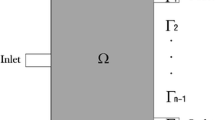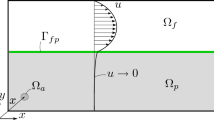Abstract
Porous media enable the intimate contact between a fluid and a functional solid that can accomplish tasks valuable to chemical engineers, such as catalytic reaction, chemical separations, chemical species detection, and filtration. New additive manufacturing technologies facilitate the creation of porous media with precise control of the geometry of each pore, which could enable improved performance and more flexible design of chemical engineering devices. However, new design tools are needed to accomplish this. In this paper, we analyze an optimization problem, constrained by Darcy’s law, to design porous media columns that achieve uniform transit times of fluid particles, despite having nonuniform geometries. The design/control parameter in this setting is a spatially variable scalar permeability function. We prove existence of solutions to our problem, as well as differentiability, which enables the use of rapidly converging, derivative-based optimization methods. We demonstrate our approach on two axisymmetric columns where we achieve a desired velocity field with uniform transit times despite varying device cross sections. When implemented through our separately released source code, our approach provides a convenient and widely applicable means to design additively manufactured porous media and devices that use them.








Similar content being viewed by others
References
Adams R, Fournier J (2003) Sobolev spaces. Elsevier, Oxford
Antil H, Kouri DP, Lacasse MD et al (2018) Frontiers in PDE-constrained optimization, The IMA Volumes in Mathematics and its Applications, vol 163. Springer, New York,. https://doi.org/10.1007/978-1-4939-8636-1
Arenas L, de Leon C, Walsh F (2017) Engineering aspects of the design, construction and performance of modular redox flow batteries for energy storage. J Energy Storage 11:119–153. https://doi.org/10.1016/j.est.2017.02.007
Assous F, Ciarlet P Jr, Labrunie S (2002) Theoretical tools to solve the axisymmetric maxwell equations. Math Methods Appl Sci 25(1):49–78
Avila P, Montes M, Miro E (2005) Monolithic reactors for environmental applications, a review on preparation technologies. Chem Eng J 109(1–3):11–36. https://doi.org/10.1016/j.cej.2005.02.025
Bartels S (2016) Numerical approximation of partial differential equations. In: Texts in applied mathematics. Springer, Cham. https://doi.org/10.1007/978-3-319-32354-1
Bernardi C, Dauge M, Maday Y et al (1999) Spectral Methods for Axisymmetric Domains. Series in applied mathematics. Gauthier-Villars, Paris
Blacker TD, Owen SJ, Staten ML, et al (2016) Cubit geometry and mesh generation toolkit 15.2 user documentation https://doi.org/10.2172/1457612
Borrvall T, Petersson J (2003) Topology optimization of fluids in Stokes flow. Int J Numer Meth Fluids 41(1):77–107. https://doi.org/10.1002/fld.426
Byrd RH, Lu P, Nocedal J et al (1995) A limited memory algorithm for bound constrained optimization. SIAM J Sci Comput 16(5):1190–1208. https://doi.org/10.1137/0916069
Dauge M (1992) Neumann and mixed problems on curvilinear polyhedra. Integral Equ Operator Theory 15(2):227–261. https://doi.org/10.1007/BF01204238
Dias M, Fernandes P, Guedes J et al (2012) Permeability analysis of scaffolds for bone tissue engineering. J Biomech 45(6):938–944. https://doi.org/10.1016/j.jbiomech.2012.01.019
Erdim E, Akgiray O, Demira I (2015) A revisit of pressure drop-flow rate correlations for packed beds of spheres. Powder Technol 283:488–504. https://doi.org/10.1016/j.powtec.2015.06.017
Ern A, Guermond JL (2021) Finite elements. I, Texts in Applied Mathematics, vol 72. Springer, Cham, https://doi.org/10.1007/978-3-030-56341-7
Ervin VJ (2013) Approximation of axisymmetric darcy flow using mixed finite element methods. SIAM J Numer Anal 51(3):1421–1442. https://doi.org/10.1137/120861631
Evgrafov A (2005) The limits of porous materials in the topology optimization of stokes flows. Appl Math Optim 52(3):263–277. https://doi.org/10.1007/s00245-005-0828-z
Gesztesy F, Mitrea M (2011) A description of all self-adjoint extensions of the Laplacian and Kreĭn-type resolvent formulas on non-smooth domains. J Anal Math 113:53–172. https://doi.org/10.1007/s11854-011-0002-2
Gong H, Bickham BP, Woolley AT et al (2017) Custom 3d printer and resin for 18\(\mu \)m \(\times \) 20\(\mu \)m microfluidic flow channels. Lab Chip 17:2899–2909. https://doi.org/10.1039/C7LC00644F
Grisvard P (2011) Elliptic problems in nonsmooth domains, classics in applied mathematics, vol 69. Society for Industrial and Applied Mathematics (SIAM), Philadelphia, https://doi.org/10.1137/1.9781611972030.ch1
Guest J, Prevost J (2006) Optimizing multifunctional materials: design of microstructures for maximized stiffness and fluid permeability. Int J Solids Struct 43(22–23):7028–7047. https://doi.org/10.1016/j.ijsolstr.2006.03.001
Guest JK, Prevost JH (2006) Topology optimization of creeping fluid flows using a Darcy-Stokes finite element. Int J Numer Meth Eng 66(3):461–484. https://doi.org/10.1002/nme.1560
Guest JK, Prevost JH (2007) Design of maximum permeability material structures. Comput Methods Appl Mech Eng 196(4–6):1006–1017. https://doi.org/10.1016/j.cma.2006.08.006
Heroux MA, Willenbring JM (2012) A new overview of the Trilinos project. Sci Program 20(408):130. https://doi.org/10.3233/SPR-2012-0355
Heroux MA, Bartlett RA, Howle VE et al (2005) An overview of the Trilinos project. ACM Trans Math Softw 31(3):397–423
Kaszyca K, Danilczuk W, Zybala R (2019) Porous volumetric structures obtained by additive manufacturing technologies. Mater Elektron 47(1–4):15–21. https://doi.org/10.34769/tmjb-1g07
Klumpp M, Inayat A, Schwerdtfeger J et al (2014) Periodic open cellular structures with ideal cubic cell geometry: Effect of porosity and cell orientation on pressure drop behavior. Chem Eng J 242:364–378. https://doi.org/10.1016/j.cej.2013.12.060
Kouri DP, Ridzal D, Von Winckel G (2022) Rapid Optimization Library 2.0 https://trilinos.github.io/rol.html
Kuzmin D, Shashkov M, Svyatskiy D (2009) A constrained finite element method satisfying the discrete maximum principle for anisotropic diffusion problems. J Comput Phys 228(9):3448–3463. https://doi.org/10.1016/j.jcp.2009.01.031
Lazarov BS, Sigmund O (2011) Filters in topology optimization based on Helmholtz-type differential equations. Internat J Numer Methods Engrg 86(6):765–781. https://doi.org/10.1002/nme.3072
Li H (2011) Finite element analysis for the axisymmetric Laplace operator on polygonal domains. J Comput Appl Math 235(17):5155–5176. https://doi.org/10.1016/j.cam.2011.05.003
Lin CJ, Moré JJ (1999) Newton’s method for large bound-constrained optimization problems. SIAM J Optim 9(4):1100–1127. https://doi.org/10.1137/S1052623498345075
Lin S, Zhao L, Guest JK et al (2015) Topology optimization of fixed-geometry fluid diodes. J Mech Design 137(8):081402
Liska R, Shashkov M (2008) Enforcing the discrete maximum principle for linear finite element solutions of second-order elliptic problems. Commun Comput Phys 3(4):852–877
Liu DC, Nocedal J (1989) On the limited memory BFGS method for large scale optimization. Math Program 45(1):503–528. https://doi.org/10.1007/BF01589116
Palumbo V, Romano A, Lisitano J, et al (2017) Porous devices made by laser additive manufacturing. https://patents.google.com/patent/US20170239726A1. https://patents.google.com/patent/US20170239726A1, uS Patent Application US 2017/0239726 A1
Rebelo NFB, Andreassen KA, Suarez RLI et al (2018) Pressure drop and heat transfer properties of cubic iso-reticular foams. Chem Eng Process 127:36–42. https://doi.org/10.1016/j.cep.2018.03.008
Salloum M, Robinson D (2018) A numerical model of exchange chromatography through 3-D lattice structures. AIChE J 64(5):1874–1884. https://doi.org/10.1002/aic.16108
Salloum M, Robinson DB (2022) Optimization of flow in additively manufactured porous columns with graded permeability. AIChE J 68(9):e17756. https://doi.org/10.1002/aic.17756
Sanders ED, Pereira A, Paulino GH (2021) Optimal and continuous multilattice embedding. Sci Adv 7(16):eabf4838. https://doi.org/10.1126/sciadv.abf4838
Savaré G (1998) Regularity results for elliptic equations in Lipschitz domains. J Funct Anal 152(1):176–201. https://doi.org/10.1006/jfan.1997.3158
Snyder L, Kirkland J, Dolan J (2009) Introduction to modern liquid chromatography, 3rd edn. Wiley, Hoboken
Tartar L (2009) The general theory of homogenization, vol 7. Lecture Notes of the Unione Matematica Italiana, vol. Springer-Verlag, Berlin, UMI, Bologna, Berlin. https://doi.org/10.1007/978-3-642-05195-1
Tien C, Ramarao B (2007) Granular filtration of aerosols and hydrosols, 2nd edn. Elsevier, Boston
Tröltzsch F (2010) Optimal control of partial differential equations, Graduate Studies in Mathematics, vol 112. Am Math Soc Providence. https://doi.org/10.1090/gsm/112
Whitaker S (1986) Flow in porous media I: a theoretical derivation of Darcy’s Law. Transp Porous Media 1(1):3–25. https://doi.org/10.1007/BF01036523
Wiker N, Klarbring A, Borrvall T (2007) Topology optimization of regions of Darcy and Stokes flow. Int J Numer Meth Eng 69(7):1374–1404. https://doi.org/10.1002/nme.1811
Woodward IR, Attia L, Patel P et al (2021) Scalable 3d-printed lattices for pressure control in fluid applications. AIChE J 67(12):e17452. https://doi.org/10.1002/aic.17452
Zhao X, Zhou M, Sigmund O et al (2018) A “poor man’s approach’’ to topology optimization of cooling channels based on a darcy flow model. Int J Heat Mass Transf 116:1108–1123. https://doi.org/10.1016/j.ijheatmasstransfer.2017.09.090
Zheng X, Smith W, Jackson J et al (2016) Multiscale metallic metamaterials. Nat Mater 15(10):1100–1106. https://doi.org/10.1038/NMAT4694
Acknowledgements
HA is partially supported by NSF Grants DMS-2110263, DMS-1913004 and the Air Force Office of Scientific Research under Award No: FA9550-22-1-0248. DPK, DR, DBR and MS are supported by Sandia National Laboratories’ Laboratory Directed Research and Development program. Sandia National Laboratories is a multimission laboratory managed and operated by National Technology and Engineering Solutions of Sandia, LLC., a wholly owned subsidiary of Honeywell International, Inc., for the U.S. Department of Energy’s National Nuclear Security Administration under grant DE-NA-0003525. This paper describes objective technical results and analysis. Any subjective views or opinions that might be expressed in the paper do not necessarily represent the views of the U.S. Department of Energy or the United States Government.
Author information
Authors and Affiliations
Corresponding author
Additional information
Publisher's Note
Springer Nature remains neutral with regard to jurisdictional claims in published maps and institutional affiliations.
Rights and permissions
Springer Nature or its licensor (e.g. a society or other partner) holds exclusive rights to this article under a publishing agreement with the author(s) or other rightsholder(s); author self-archiving of the accepted manuscript version of this article is solely governed by the terms of such publishing agreement and applicable law.
About this article
Cite this article
Antil, H., Kouri, D.P., Ridzal, D. et al. Uniform flow in axisymmetric devices through permeability optimization. Optim Eng (2023). https://doi.org/10.1007/s11081-023-09820-0
Received:
Revised:
Accepted:
Published:
DOI: https://doi.org/10.1007/s11081-023-09820-0




